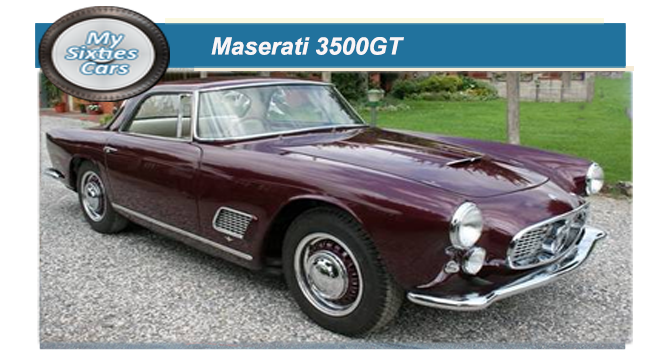
The Maserati 3500 GT was Introduced in 1957, purportedly as, a successor to the A6G/2000 that had remained in production for close to ten years as Maserati’s first road car.
However motoring historians of the era saw the 3500GT as more than just a replacement, instead representing the gradual evolution of Maserati from the racing car manufacturer to fully fledged road car builder.
Immensely 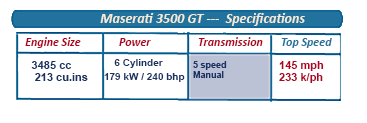 stylish for the times, the 3500GT was Maserati's first model that was designed to be produced in commercial quantities.
stylish for the times, the 3500GT was Maserati's first model that was designed to be produced in commercial quantities.
Responsible for the beautiful body design was Giovanni Michelotti, lead designer for the Turin based workshop Vignale, who would go on to enjoy a long and fruitful working relations ship with Maserati.
The front
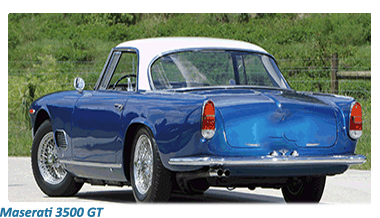 end was similar to the A6G/2000, although containing a recessed egg crate-patterned grille with round trident insignia in the centre.
end was similar to the A6G/2000, although containing a recessed egg crate-patterned grille with round trident insignia in the centre.
Round parking lights and large round auxiliary lights again were installed, with vertical tail lamps and a mild wraparound rear window, along with rounded tailfins.
Grilled air intakes were installed on the lower cowl and an air-scoop in the hood. The design was the work of Giulio Alfieri (Maserati's chief engineer).
![]()
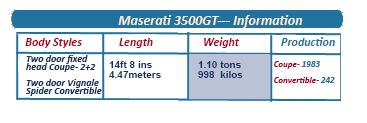 Front disc brakes joined the options list in 1959 and were standard in 1960. In 1959, the Touring designed body added front vent wing, Center-lock wire wheels were optional. So was a limited-slip differential.
Front disc brakes joined the options list in 1959 and were standard in 1960. In 1959, the Touring designed body added front vent wing, Center-lock wire wheels were optional. So was a limited-slip differential.
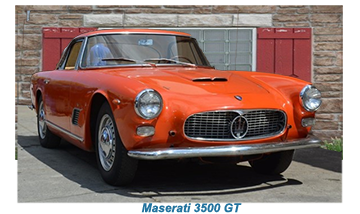 Most of the Maserati 3500 GT coupes were built by Touring, while the Spider roadster was produced by Vignale, using the same large-diameter tubular chassis similar to that employed in the A6 series.
Because they were custom-bodied, no two were quite alike.
The Touring coupe had a straight fender line, with air vents behind front wheel wells. The rigid rear axle was connected to the frame by rods above and cantilever leaf springs below.
The launch of the 3500GT signalled Maserati's move into the premier league of Italian car manufacturers, allowing it to take its place alongside Ferrari as a builder of some of the world's most desirable cars.
Most of the Maserati 3500 GT coupes were built by Touring, while the Spider roadster was produced by Vignale, using the same large-diameter tubular chassis similar to that employed in the A6 series.
Because they were custom-bodied, no two were quite alike.
The Touring coupe had a straight fender line, with air vents behind front wheel wells. The rigid rear axle was connected to the frame by rods above and cantilever leaf springs below.
The launch of the 3500GT signalled Maserati's move into the premier league of Italian car manufacturers, allowing it to take its place alongside Ferrari as a builder of some of the world's most desirable cars.
![]()
Most of the mechanics were the same as the fixed head models, but the Vignale-built bodies were substantially different from the Touring coupes as well as being produced in steel. While their principal rivals Ferrari seemed purely interested in sheer performance, Maserati was more concerned that its 3500GT was a practical and consummate grand tourer. Owners wer
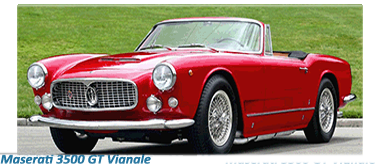 e treated to more luxury and technical equipment than any other car manufacturer in the same category.
The release and market consolidation of the 3500GT was, in fact, a major triumph for Maserati, with the new model going on to form the basis for several later models, enhancing the company's reputation and providing confidence and financial ability to start building some real supercars to take on Ferrari.
Maserati did not just emphasise speed, but marketed their cars on opulence as well, making for a more inviting environment than you would find in an equivalent luxury sports car of the era.
e treated to more luxury and technical equipment than any other car manufacturer in the same category.
The release and market consolidation of the 3500GT was, in fact, a major triumph for Maserati, with the new model going on to form the basis for several later models, enhancing the company's reputation and providing confidence and financial ability to start building some real supercars to take on Ferrari.
Maserati did not just emphasise speed, but marketed their cars on opulence as well, making for a more inviting environment than you would find in an equivalent luxury sports car of the era.






